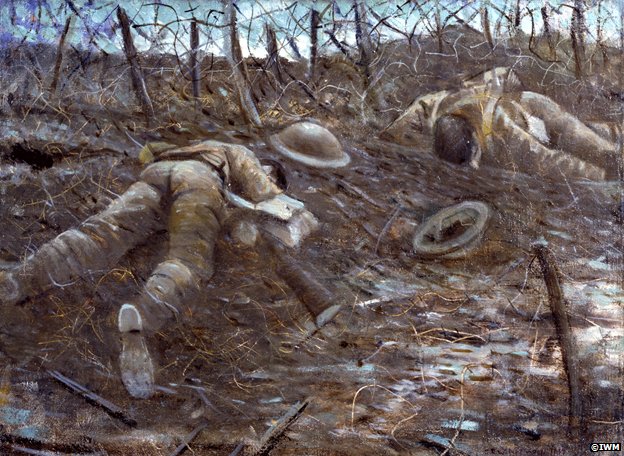In BBC News Magazine, Alan Little looks at some early WW1 art that fell afoul of the censors for being too accurate:

What you notice first about the two figures in Christopher Nevinson’s painting Paths of Glory is the banality of their deaths. Their commonplace, mundane fate. They lie face down in the blasted earth, two men in British military fatigues, their helmets and rifles lying in the mud beside them.
They are indistinguishable from each other, stripped of individual identity. Nothing marks them out as the unique human beings they must once have been with names, and families, and remembered childhoods, and desire and love and hope and ambition.
From the bottom left of the composition, where the corpse in the foreground lies with the soles of his boots facing you, your eye moves diagonally upwards and to the right, to the second dead man, who has fallen forwards towards you, and you see the top of his dark head but Nevinson denies you a glimpse of his face. He has no face, no personality, no story of his own. In colour, texture and even contour, the lifeless bodies are almost indistinguishable from the land on which they lie, and which will now swallow them.
In my time as a war reporter for the BBC I have come across scenes like this. You cannot mistake the recently dead for the sleeping, for there is something bloodless, something shockingly, arrestingly lifeless about them. I have found myself transfixed by odd detail — a bootlace tied just a few hours ago, by fingers that will now never move again. What talents lie locked into the muscle memory of those fingers? Could they, as recently as this morning, have picked out a melody on a piano? With the death of each individual, an entire universe vanishes.
[…]
I think of those two young men whose names I never learned when I look at Nevinson’s Paths of Glory. Its title is taken from Thomas Gray’s Elegy Written in a Country Church-Yard. “The boast of heraldry, the pomp of pow’r, / And all that beauty, all that wealth e’er gave / Awaits alike th’inevitable hour. / The paths of glory lead but to the grave.”
Government censors did not like Paths of Glory. They judged it bad for morale and refused to pay Nevinson for it. But he included it anyway in the first exhibition of his war paintings in London early in 1918, with a brown paper strip across the canvas carrying the word “censored”. He was reprimanded both for exhibiting a censored painting and, bizarrely, for unauthorised use of the word “censored” in a public place. But the painting was bought, during that exhibition, by the Imperial War Museum, where it remains.



